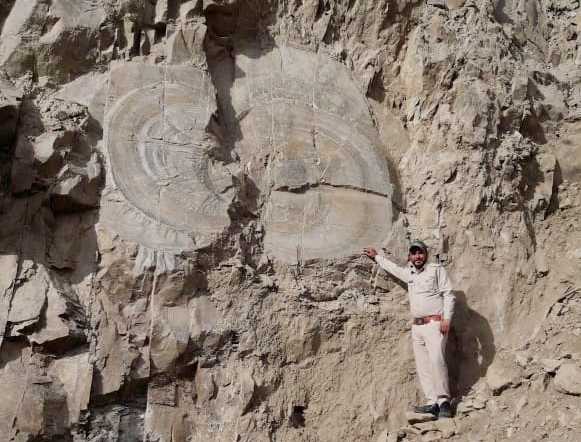Over 67 million-year-old tree fossil found in Shimla district in India
A tree fossil estimated to be over 67 million years old has been found near Kharapathar in the district, an expert said on Thursday. The fossilised tree belongs to the Mesozoic era, Hari Chauhan, curator of State Museum and a fossil expert who visited the spot, said. The Mesozoic era is the age of dinosaurs, and lasted about 180 million years, from about 250 to 65 million years ago.
Rohru’s Divisional Forest Officer (DFO) Chandulal Tahsildar said he found the fossils during a site visit to the area in connection with complaints of illegal filling. He said frequent landslides that the area experienced recently could have brought the fossils to the surface.
“It was during my visit to the place on March 30 that I chanced upon these fossils that obviously seemed to look very old,” he said, adding that the tree stumps were nearly 11×8 feet and elliptical.

Chauhan, who visited the site, said the discovery could either be tree fossils or geological formations.
“It’s a very important discovery either way,” he said, adding that such fossils, while not uncommon in the Shiwalik ranges, were rare in Himalayan ranges. Similar fossils have been found in Spiti.
“If it’s a tree fossil, it’s very important from the point of view of paleontological studies. And if it’s a geological formation, then it’s a crucial discovery in the field of geological studies,” he said, adding a team of geologists and forest officials would join him in thoroughly searching the area.
Meanwhile, the latest discovery will be protected.
About Fossils :
A fossil is the remains or trace of an ancient living thing. Fossils of animals, plants, or protists occur in sedimentary rock. In a typical fossil, the body form is retained, but the original molecules that made up the body have been replaced by some inorganic materials, such as calcium carbonate (CaCO3) or silica (SiO2). The fossil feels like, and is, made of rock. It has been mineralised or petrified(literally, turned into rock).
A fossil may also be an imprint or impression of a living thing remaining in the fossilised mud of a long-gone age. Some organisms fossilise well, others do not.
The most common fossils are those left behind by organisms that produce hard materials. The hard, calcitic shells of molluscs (such as clams and snails) and of now-rare brachiopods (also known as lampshells) are examples. These sea-dwelling shellfish have produced many fossiliferous (that is, fossil-bearing) chalky layers of limestone in the earth.
Soft-bodied organisms can fossilise in special circumstances: the Ediacaran biota is a good example. The best-known fossils for the general public are those of the giant, prehistoric dinosaurs. The fossilized bones and fossilized tracks of these huge, ancient reptiles can be seen in many museums of natural history and earth science.
The study of fossils by geologists and biologists is known as palaeontology. If the study puts living things in their ecological context it is called paleobiology.
Mesozoic Era :
The Mesozoic Era is the age of the dinosaurs and lasted almost 180 million years from approximately 250 to 65 million years ago. This era includes 3 well known periods called the Triassic, Jurassic, and cretaceous periods.
A mass extinction marked the beginning and end of the Mesozoic Era. The event that caused the transition from the Paleozoic era to the Mesozoic era was the greatest extinction this earth has seen. This extinction wiped out about 95% of all marine life and 70% of land life. This allowed the dinosaurs to step in and settle into their role as the lords of the earth. The era ended with “The Great Extinction” which marked the end of the dinosaurs as the Cenozoic era began.
Tectonics :
At the beginning of the Mesozoic era, the continents as we know them were joined together as the massive mother continent, Pangaea. It was during the age of the dinosaurs that Pangaea was transformed into the modern continents.
Pangaea became two great continents known as Laurasia and Gondwana and the Atlantic Ocean began to grow. Laurasia eventually split into the continents of North America and Eurasia. Gondwana became the modern continents of South America, Africa, Australia, Antarctica, and the Indian subcontinent, which, after the Mesozoic era, collided with Eurasia forming the Himalayas.
Environment :
The environment was unusually warm and polar ice caps did not yet exist. This played a large part in the evolution and is a key factor behind the flourishing of the dinosaurs.
During the Triassic period, the climate was generally dry, which changed near the Jurassic period as oceans began to rise due to mounting layers of magma covering the seafloor. As a result, flooding overtook many parts of the exposed land.
This allowed the climate to change with increased humidity and it continued that way even into the Cretaceous period. However, the climate began to cool during the Cretaceous although temperatures may have risen again near the end of the Mesozoic.
